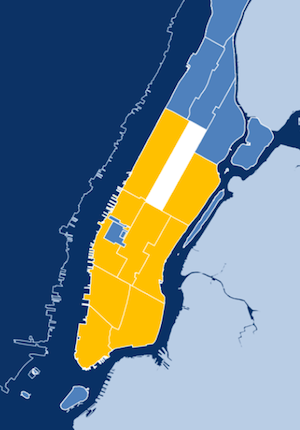This afternoon, the City Council passed the Manhattan Core parking text amendment with a vote of 47-0, with one abstention (Jessica Lappin). The zoning change, which modifies off-street parking rules in the densest parts of Manhattan, is as good as law now, with Mayor Michael Bloomberg's approval basically a given.

The zoning change modifies the city's 1982 shift from mandatory parking minimums to parking maximums in this part of Manhattan, which was spurred by the Clean Air Act. The regulations apply to Manhattan below West 110th Street and East 96th Street with limited exceptions, including Hudson Yards on the Far West Side. Parking minimums are still in force in almost all of the rest of the city.
The amendment includes a number of positive changes, including:
- Removing language that could be read as requiring parking for affordable housing units;
- Allowing buildings built before 1982, which had been required to build parking, to reduce or eliminate parking, though permission must be obtained from the City Planning Commission;
- Expanding the amount of space allowed in commercial districts for car rental and car-sharing vehicles; and
- Providing regulations governing the design and operation of automated parking garages.
The amendment would also weaken the distinction between public parking spaces, which can be used by anyone, and accessory parking spaces, which are intended for a building's tenants and visitors. The new regulations allow accessory spaces to be opened to the public, giving developers a green light to build publicly-accessible parking until they reach the maximums in the zoning code -- set at 20 percent of residential units below 60th Street and 35 percent of units on the Upper East Side and Upper West Side.
Many garages that were built for use by building tenants are currently operated and licensed by the Department of Consumer Affairs as public garages -- no one enforces the rule against turning accessory parking into public parking. Instead of trying to tweak this laxly enforced system, the new regulations legitimize the existing practice of treating nearly all parking as public parking.
Some experts, including David King of Columbia University, argue that accessory parking should be eliminated entirely and replaced with a "shared parking" model that treats the total parking supply as a pool available to the public. The accessory parking model is fundamentally flawed, King says, because it assumes that certain land uses have an intrinsic need for parking that should be met by the zoning code. Weakening the accessory parking model is "the single best thing the city could do," King told Streetsblog after DCP released the proposal last November. "It is a necessary prerequisite for any future parking reform."
Building parking in excess of the maximum requires a special permit from the City Planning Commission, which must make certain findings before granting one. If the bar is set high, it discourages developers from pursuing a permit in the first place. This process will still exist, but some advocates were concerned that the proposed changes would significantly lower the bar for obtaining permits, opening the gates for a flood of new public parking.
The latest updates to the proposal seem to have assuaged those fears, to a point. "The major loophole -- the freedom of the Planning Commission to issue special permits for virtually any reason -- has been theoretically curtailed, but we will have to see how the new rules work in practice," environmental planner Dan Gutman told Streetsblog via e-mail.
The proposal, which proceeded without comment from Borough President Scott Stringer, was passed by the City Planning Commission on March 20 and approved by the City Council's Land Use committee last Thursday. It now goes to Mayor Bloomberg for a five-day review period, after which it becomes law.





